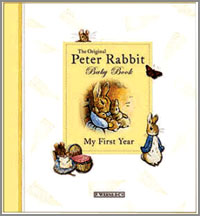|
Beatrix Potter
Great story teller and illustrator
 Let
me introduce Miss Potter to you - no relation of Harry Potter. She died
about half a century before Harry Potter was conceived in J. K.
Rowling's mind. Let
me introduce Miss Potter to you - no relation of Harry Potter. She died
about half a century before Harry Potter was conceived in J. K.
Rowling's mind.
She is Beatrix Potter, who created those lovable animal characters,
Peter Rabbit, Jemima Puddle Duck, Tailor of Gloucestor and others and
enriched English children's literature with their 'Tales' at the
beginning of the last century. Some of you may have read these 'Tales'.
My favourite is The Tailor of Gloucestor.
The 'Tale of Beatrix Potter' begins in 1866 in South Kensington, a
new suburb of London. She was born on July 28, 1866 and her parents
named her Helen Beatrix. She had an older brother, Benjamin.
Her parents were rich. They employed a governess to teach her at
home, but her older brother was sent to boarding school. Beatrix had no
sister or friend to keep her company. Anyway, she was not a child who
wanted company. When not at lessons, she spent her time in a
make-believe world with her pets.
Rabbits were her favourites, there were squirrels and even mice. The
school-room on the third floor of their house was full of little animals. She found "common wild ones more
intelligent and amusing" than the usual pets like cats and dogs.
house was full of little animals. She found "common wild ones more
intelligent and amusing" than the usual pets like cats and dogs.
Beatrix was a keen observer of her surroundings - houses, rooms,
roofs, furniture, gardens and all creatures big and small that lived in
the grass and in the creepers and bushes. She noted little details.
She had a flair (inborn ability) for drawing, and she couldn't keep
back the urge to sketch whatever caught her attention, be it a price of
old furniture, the shape of a roof or even a bucket. Art was her first
love and nature her second.
She spent a lot of time sketching insects and little animals,
sometimes using her brother's microscope to see details like the
markings on wings of a moth. By the age of 19, she had mastered the art
of using brush and water-colours.
She created a fantasy world around her pets and drew them dressed in
skirts and coats, hats and scarfs. By 1891, her illustrations were being
used for greeting cards. Some of her drawings were used as illustrations
in a book of nursery rhymes.
She had a vivid imagination and made up stories about her pets. She
began relating these stories in letters she wrote to children of cousins
and governesses, each story was illustrated with her own drawings.
Once, she wrote to a sick child about a naughty rabbit that lived
under the roots of a fir tree with his mother and well-behaved sisters
Flopsy, Mopsy and Cottontail. The sick child's mother was once her
governess. She suggested getting this picture-letter published as a
book.
Beatrix took up the governess' suggestion and wrote to a publisher.
The publisher showed some interest in the story, but was not ready to
risk his money on an unknown writer and illustrator.
She decided to publish the book herself, and paid for the printing of
a small number of copies. The Tale of Peter Rabbit (printed in 1901)
sold very fast. She wrote to the publisher again. The publisher Fredrick
Warne and Co had, by now, seen that there was a market for small
illustrated story books. Norman Warne, the youngest member of the family
firm, had another look at the book and decided to publish it.
Beatrix Potter was delighted. A contract was drawn in 1902 and
Beatrix started re-drawing the illustrations using a new rabbit as a
model because the original rabbit had died the previous year.
Beatrix Potter was not going to give the publisher a free hand. She
had definite ideas about the size and layout of the book and what it
should look like. It had to be a little book, that even very small
children could hold in their hands.
The text and the pictures had to be on separate facing pages and the
price had to be low. Norman Warne worked very closely with her, keeping
to her instructions. The Tale of Peter Rabbit was a great success.
 The
first printing sold out before publication. Children took Peter Rabbit
to their hearts and the book was re-printed six times. No one was more
surprised than Beatrix Potter. The
first printing sold out before publication. Children took Peter Rabbit
to their hearts and the book was re-printed six times. No one was more
surprised than Beatrix Potter.
With Peter Rabbit, Beatrix Potter had created a new form of animal
fable. More Tales, followed; The Tale of Squirrel Nutkin (1903), Tale of
Benjamin Bunny (1904), Tale of Two Bad Mice (1905) and The Tailor of
Gloucester, all illustrated with her water-colour drawings.
These little stories were translated into German, French, Spanish and
Welsh. Like our own Sybil Wettasinghe, Beatrix Potter was gifted with
two unique talents; they are both excellent story-tellers with a fertile
imagination, skilled artists, they tell the story in words and
illustrations showing the characters in action. Very few are gifted with
both these talents - the art of story-telling and the ability to draw.
The books brought her money and also independence. Her fifth book The
Tale of Mrs. Tiggy Winkle was nearing completion, when she received a
letter from Norman Warne, asking her to marry him.
The publisher and writer had been very happy working together and
their respect for each other had deepened into love. He gave her a ring
and she wore it proudly, but her mother didn't approve of Norman Warne,
a man in the printing trade, as a suitor for her only daughter. A quiet
but desperate struggle of wills followed.
When the family went to Wales for their summer holiday, Beatrix
Potter dutifully went with them. She didn't see Norman Warne again. He
fell ill and died of a virulent (strong)form of leukaemia.
It took years for Beatrix Potter to get over her grief. She bought a
farm far away from London and took to sheep farming. She stopped
writing. Instead, she worked hard, breeding sheep.
There she met a local lawyer William Heelis, a gentle quiet man who
shared her love of the land, and she married him in 1913; she was then
47 years. She spent the next 30 years on the farm in the village of
Sawrey in Lankcashire until her death in 1943.
She bequeathed her property to the National Trust. Her original home,
Hilltop Farm is maintained by the National Trust. A film on her life and
work, titled Miss Potter was released in January this year.
Sumana Saparamadu |
